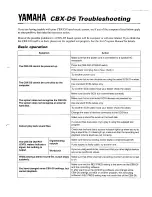
23
THERMOSTAT OPERATION
TA32W01 Thermostat - Continued
Before you begin programming your thermostat, you should be familiar with its features and with the display and the location and
operation of the thermostat buttons. Your thermostat consists of two parts: the thermostat cover and the base. To remove the
cover, pull it straight out from the base. To replace the cover, line up the cover with the base and press until the cover snaps onto
the base.
The system “mode” is selected by pressing the SYSTEM button. Icons on the botton right corner of the display will indicate the
mode:
COOL
( ),
AUTO
( ),
HEAT
( ),
EMER
, or
OFF
. In any mode except
OFF
, the setpoint temperature will be shown on the
right side of the display. In
OFF
, this area will be blank. The current temperature will be displayed on the left side of the display.
To operate properly in the
AUTO
mode, the heat setpoint temperature cannot be the same as or higher than the cool setpoint
temperature. The heat setpoint must be at least 1° lower than the cool setpoint.
Automatic System Changeover
When the thermostat is in the
AUTO
mode, both the Flame and Snowfl ake icons are displayed. The thermostat will call for heat
or cool depending on the room temperature. The setpoint temperature displayed will be that of the last mode called. If the last
system cycle was heat, the
HEAT
setpoint will be displayed. If the room temperature raises above the
HEAT
setpoint and the
COOL
setpoint and a for cool is required, the temperature displayed will change to be the
COOL
setpoint.
Second Stage Time Delay
Your thermostat is designed to determine the optimum time to activate the second stage. Simply raising the temperature in heat-
ing or lowering it in cooling will not always force the thermostat to bring the second stage on quickly. There is a time delay from
0-30 minutes depending on the performance of the fi rst stage of the system.
EXAMPLE:
For the last 2 hours the thermostat is set on 70° and the room temperature is 70° with the equipment using only
the fi rst stage of heat. Since the equipment is keeping the temperature within 1° of setpoint, the thermostat will delay second
stage for a longer time if you manually raise the temperature or if the room temperature quickly changes. Once the second stage
comes on, it will come on sooner the next time there is a difference between the setpoint and the room temperature. The net
effect of the staging program is that when the fi rst stage is capable of making temperature the second stage will delay longer.
When the thermostat calculates that fi rst stage cannot make temperature in a reasonable time, the second stage will come on
sooner. This built in function automatically optimizes the use of additional stages of heat or cool.
For more information on thermostat operation, refer to the instruction manual shipped with your thermostat.
















































